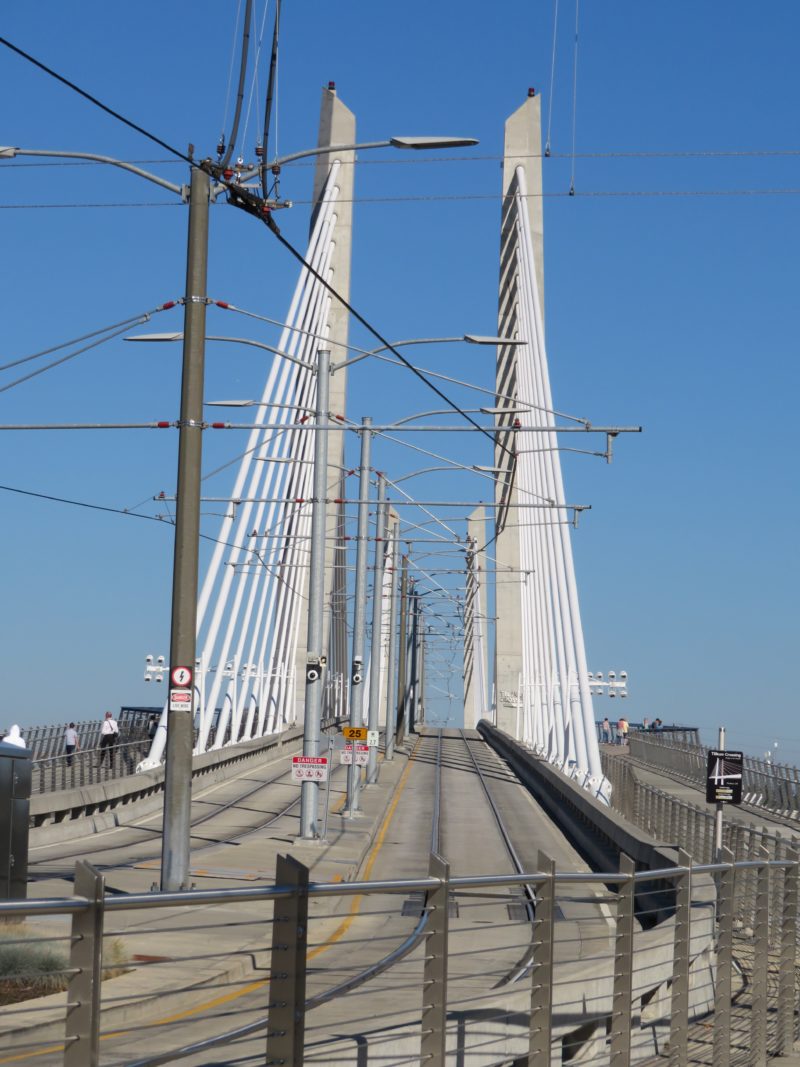A dear friend of mine has been longing to walk across one of the newest bridges in Portland. For a number of reasons that walk had to be postponed, so I thought I’d bring the bridge to her, until she can come to the bridge.
Voila, here is Tilikum Crossing, Bridge of the People, a cable-stayed bridge across the Willamette River designed by TriMet, the Portland metropolitan area’s regional transit authority, for its MAX Orange Line light rail passenger trains. Also allowed: bus, streetcar, bikes, emergency vehicles, foot traffic, but NO cars!
T.Y. Lin International (TYLI), Engineer of Record on the Tilikum Crossing project, designed the distinctive, 180-foot-tall, pentagonal shaped stay-cable towers as the bridge’s focal point. The 1,720-foot-long bridge also features two landside piers and two in-water piers. The 780-foot-long main span deck is separated into a 31-foot-wide transitway between the tower legs to accommodate two lanes of track and two flanking multi-use paths for pedestrians and cyclists.Cable saddles were incorporated in TYLI’s bridge design to allow for more slender, solid towers and a cleaner bridge profile. Tilikum Crossing is the first bridge in the U.S. to use the Freyssinet multi-tube saddle design, which allows each cable to run continuously from the deck, through the top of the tower and back down to the other side. Approximately 3.5 miles of cables run continuously through the tower saddle, instead of terminating in each tower.

The bridge connects two residential and industrial mixed zone neighborhoods, from the South waterfront to the central East side. The name refers to a Chinook Jargon word meaning people, tribe, or family, and the name is intended to honor the Multnomah, Cascade, Clackamas, and other Chinookan peoples who lived in the area as long as 14,000 years ago. The Tilikum name also references the pervasive use of Chinook Jargon in Portland’s first half century in the frequent trade interactions between pioneers and Native Americans
When I walked it last Friday, the sky was intensely blue, without a cloud, and the low sun at this time of the year produced intense shadows.
Tons of people were walking, strangers happily posturing for portraits with their dogs, or zipping by on bikes.
Politics made it onto the bridge as well, in subtle, welcome form.
Here are the views if you look up, down or Eastwards. The shape of the bridge is supposed to evoke the shape of Mt. Hood.
Below are some paintings of bridges of yore that I have liked over the years.
Vincent van Gogh Across the Seine at Asniere 1887
View of the Brooklyn Bridge by Emil Renoufe 1889
Cardiff Bridge and Castle JMW Turner 1795-6
Paul Klee Die Rote Bruecke 1928
Ernest Lawson Spring Night Harlem River 1913
Canaletto The Rialto Bridge 1726
And since it is ME writing this blog, here is a reminder that we are lucky to have safe bridges (until the big earthquake hits…)
https://www.worldatlas.com/articles/worst-bridge-disasters-in-history.html




























lee msgrave
engaging subject and images . . . love the Vincent painting. heidi and I were on the main bridge in prague a few weeks ago and really enjoyed learning about its history. we are heading to koln in a couple of days.